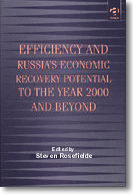"Efficiency and Russia's Economic Recovery Potential to the Year 2000 and beyond": Preface

PREFACE
This volume is the outgrowth of a long term research project begun in the late seventies funded variously by the National Academy of Sciences, the National Science Foundation and the International Research Exchange Board, which sought to assess the comparative production potential and efficiency of the Soviet socialist economy and its western market rivals using stochastic production frontiers and other methods. The initial results cast Soviet performance in a favorable light until new data acquired after the fall of communism made it clear why the original findings were mistaken.
The new information suggests that Soviet economic performance, efficiency and production potential were far poorer than previously thought and that the causes of these deficiencies persist despite significant changes in the post-Soviet economic system, constraining Russia's economic recovery potential. Although post-Soviet capitalism, vitalized by foreign assistance could still propel rapid modernization, a deeper appreciation of Russia's profound misdevelopment, and lingering communist legacy suggests that the path to free enterprise, whether along Anglo-American, European social democratic or Japanese corporatist lines is likely to be challenging.
The volume is divided into three parts. Part I elaborates the fundamentals of contemporary production function based efficiency theory as they bear on the assessment and measurement of Russia's economic recovery potential, including procedures for investment decisionmaking during the transition period. Part II presents econometric case studies using a variety of techniques, especially stochastic production frontier analysis, quantifying the efficiency and production potential of Russia and the Soviet Union from different perspectives. The performance of enterprises, sectors and the nation are studied statically, intertemporally and intersystematically at various stages of production, in a multiproduct context, sectorally and in the aggregate to assess open and concealed inefficiencies, and occasional sources of strength.











